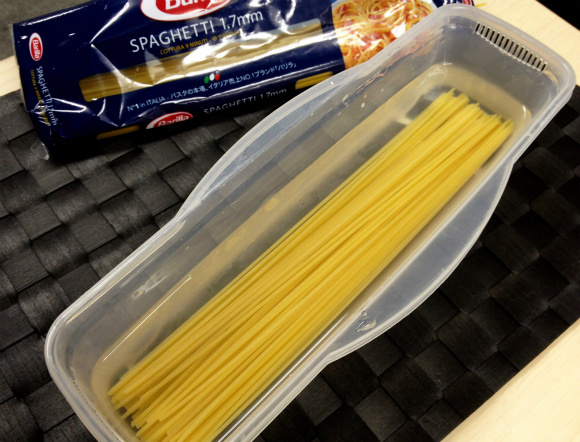
Pasta, for many of us, is the miracle food. Boil, strain, add sauce, and just like that you have a delicious dish! It’s cheap, easy, and quick–the perfect food for everyone from starving students to busy professionals. It’s even moderately healthy, as long as you choose the right sauces.
On the other hand, it’s so easy and cheap that some of us tend to eat it often enough for it to get a bit boring. If you’re starting to get tired of your dry pasta dishes, why not try using some “fresh” noodles?
If you’re thinking that making noodles by hand sounds like a lot of work, well, we’re sure you’re probably right–but our colleagues at RocketNews24 Japan have a trick that will basically revert your dry pasta back to its “fresh pasta” state!
To transform your dried pasta into fresh pasta, you only need to follow this one, simple trick: Soak your pasta in some water for an hour or more.
Well, that’s easy, isn’t it? Yes, but wait! There’s more.
So, when we heard about this, at first we were a bit skeptical. Surely dropping dry pasta into some water and letting it soak for 60 minutes isn’t enough to turn it into “fresh” pasta. If that were true, why wouldn’t everyone do it?
Well, aside from the fact that it requires you to soak your pasta for an hour before cooking, it also isn’t exactly like fresh pasta. But first, here’s how you go about soaking the pasta. Obviously, you need enough water to completely submerge the noodles. Before we said it takes over an hour, but you’re looking for something specific: The pasta should eventually turn a white color. Typically, dry pasta is a kind of yellowish color, but once the noodles have sucked up enough water, they’ll turn closer to white. You want the entire noodle to be full of water–all the way to the core.
At this point, your pasta will be soft and flexible. It will also be a bit swollen, as you can see in the photos below. If the noodles don’t look like this, you’ll want to let them soak until they do.
Now that you’ve got your soft, floppy noodles ready, you can drop them in some boiling water. We used nine-minute dry pasta for this experiment, but with our “fresh” noodles it took between one and two minutes to boil them. So this will clearly speed up the cooking process! Another interesting thing was that the fresh pasta turned half-transparent as soon as we dropped in the water.
We also boiled some of the dry pasta, which obviously took nine minutes, for comparison. In the end, the finished dry pasta and the finished “fresh” pasta basically looked the same, which was kind of disappointing. But did they taste different? Actually, yes!
▼Dry pasta
▼”Fresh” pasta, not much of a difference to be seen…
The water-soaked pasta ended up being much softer than the dry noodles. While it wasn’t exactly like truly fresh pasta, the noodles were much more pliant–like dry pasta that had been taken out at precisely the right moment. Another thing we noticed was that the “fresh” noodles smelled better.
Soaking your noodles won’t produce results identical to real fresh pasta. We have a feeling nothing will, so if fresh pasta is important to you, you’ll still need to make it yourself. On the other hand, this method produces results halfway between regular dry pasta and what you might get from handmade noodles.
▼Dry pasta and some carbonara sauce
▼Water-soaked noodles with identical carbonara sauce
So, is it worth it? Well, we’d say probably yes. For one thing, it nearly guarantees pasta feels “perfectly timed.” And it might help you save on your gas bill by drastically reducing cooking time, though we doubt you’ll notice much of a difference there. But if you’re looking for softer, more pliant noodles, just remember to soak your pasta for an hour!
If you try it out, be sure let us know how it goes! Especially if you find a better way to “freshen-up” pasta noodles.
All images by RocketNews24
[ Read in Japanese ]

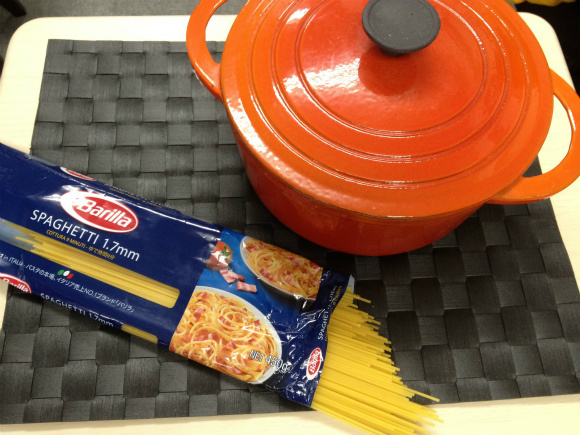
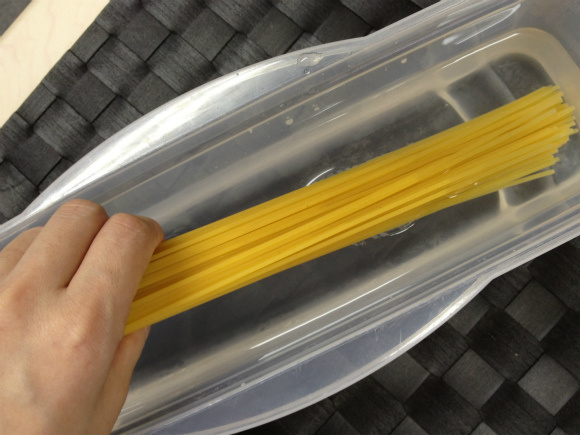
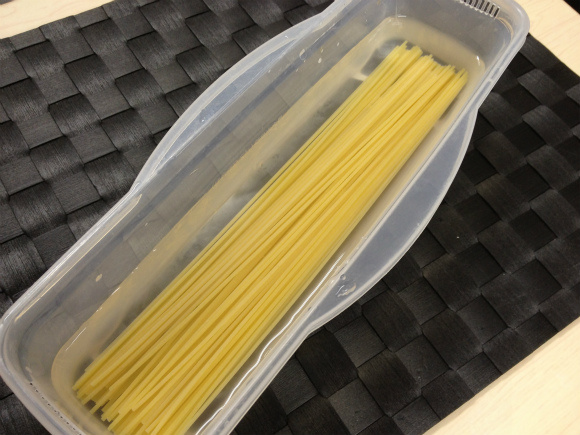
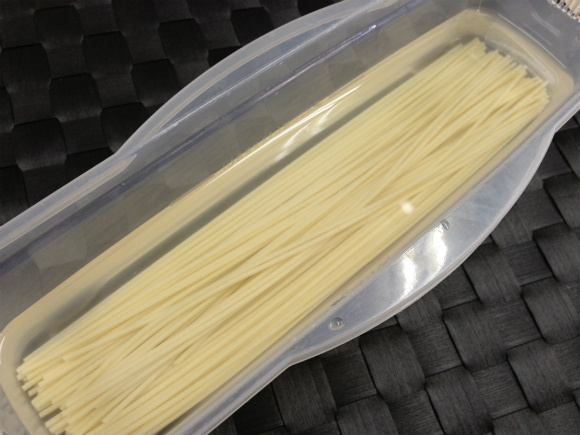
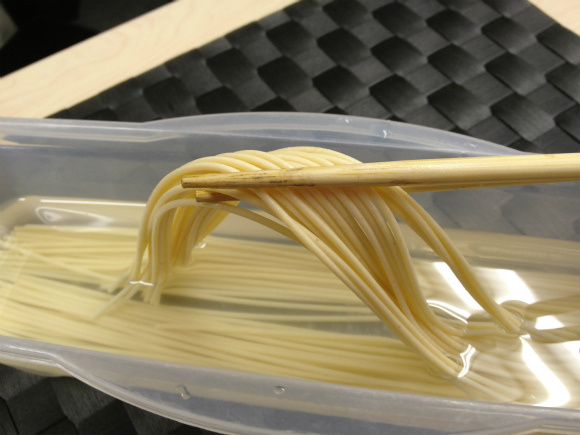
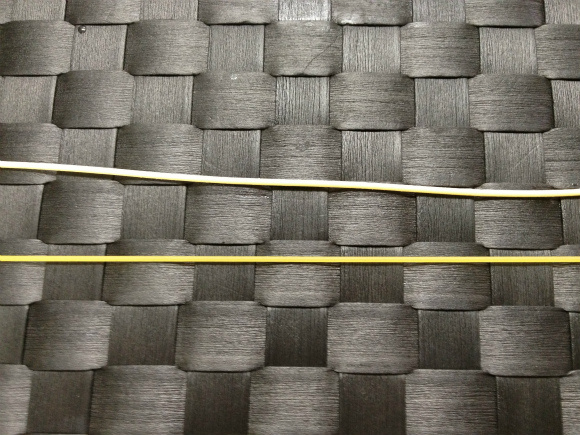
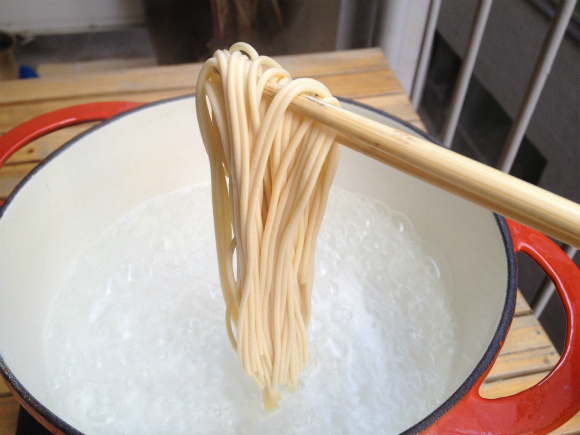
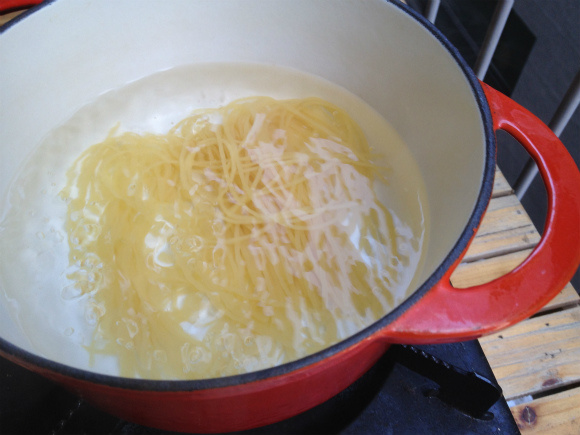
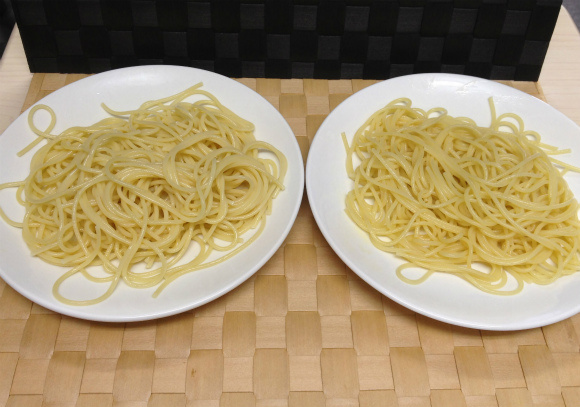
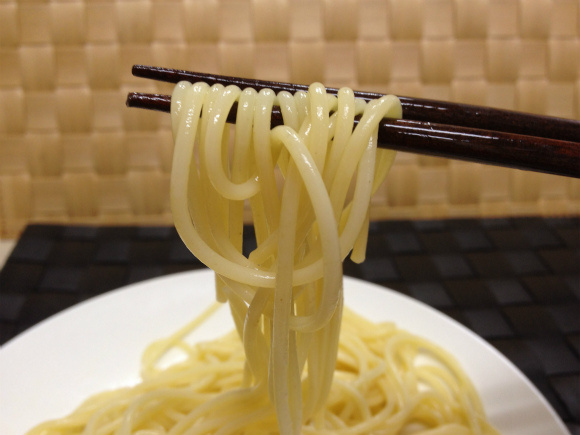

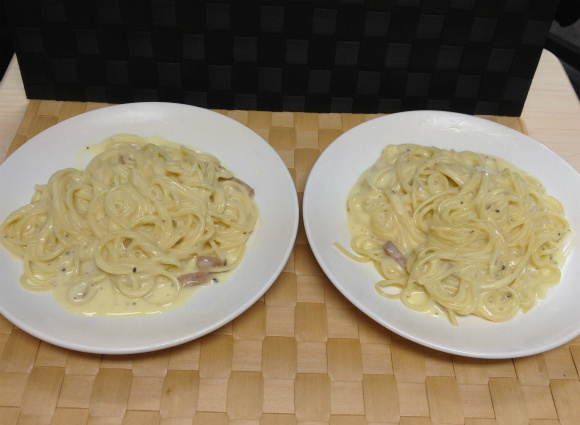


 Craving ramen, but can’t find decent noodles? Transform your spaghetti with this pasta hack!
Craving ramen, but can’t find decent noodles? Transform your spaghetti with this pasta hack! One minute is all you need to make this popular instant noodle meal from Okayama【SoraKitchen】
One minute is all you need to make this popular instant noodle meal from Okayama【SoraKitchen】 Regular cup noodle bowls not enough for you? Try this 2000+ calorie instant yakisoba instead!
Regular cup noodle bowls not enough for you? Try this 2000+ calorie instant yakisoba instead! Quite possibly the greatest food bargain in Japan: tasty convenience store pasta for less than a buck
Quite possibly the greatest food bargain in Japan: tasty convenience store pasta for less than a buck Be careful how you talk about “spaghetti” in Japanese — you may sound unhip
Be careful how you talk about “spaghetti” in Japanese — you may sound unhip McDonald’s new Happy Meals offer up cute and practical Sanrio lifestyle goods
McDonald’s new Happy Meals offer up cute and practical Sanrio lifestyle goods All-you-can-drink Starbucks and amazing views part of Tokyo’s new 170 meter-high sky lounge
All-you-can-drink Starbucks and amazing views part of Tokyo’s new 170 meter-high sky lounge Studio Ghibli glasses cases let anime characters keep an eye on your spectacles
Studio Ghibli glasses cases let anime characters keep an eye on your spectacles More foreign tourists than ever before in history visited Japan last month
More foreign tourists than ever before in history visited Japan last month Starbucks reopens at Shibuya Scramble Crossing with new look and design concept
Starbucks reopens at Shibuya Scramble Crossing with new look and design concept Beautiful Sailor Moon manhole cover coasters being given out for free by Tokyo tourist center
Beautiful Sailor Moon manhole cover coasters being given out for free by Tokyo tourist center The oldest tunnel in Japan is believed to be haunted, and strange things happen when we go there
The oldest tunnel in Japan is believed to be haunted, and strange things happen when we go there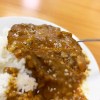 The best Japanese curry in Japan isn’t eaten at a restaurant
The best Japanese curry in Japan isn’t eaten at a restaurant Is the new Shinkansen Train Desk ticket worth it?
Is the new Shinkansen Train Desk ticket worth it? Mister Donut ready to make hojicha dreams come true in latest collab with Kyoto tea merchant
Mister Donut ready to make hojicha dreams come true in latest collab with Kyoto tea merchant Disney princesses get official manga makeovers for Manga Princess Cafe opening in Tokyo
Disney princesses get official manga makeovers for Manga Princess Cafe opening in Tokyo We try out “Chan Ramen”, an underground type of ramen popular in the ramen community
We try out “Chan Ramen”, an underground type of ramen popular in the ramen community Beautiful new Final Fantasy T-shirt collection on the way from Uniqlo【Photos】
Beautiful new Final Fantasy T-shirt collection on the way from Uniqlo【Photos】 Foreign English teachers in Japan pick their favorite Japanese-language phrases【Survey】
Foreign English teachers in Japan pick their favorite Japanese-language phrases【Survey】 There’s a park inside Japan where you can also see Japan inside the park
There’s a park inside Japan where you can also see Japan inside the park Japanese convenience store packs a whole bento into an onigiri rice ball
Japanese convenience store packs a whole bento into an onigiri rice ball Studio Ghibli releases Kiki’s Delivery Service chocolate cake pouches in Japan
Studio Ghibli releases Kiki’s Delivery Service chocolate cake pouches in Japan Japan’s bone-breaking and record-breaking roller coaster is permanently shutting down
Japan’s bone-breaking and record-breaking roller coaster is permanently shutting down New definition of “Japanese whiskey” goes into effect to prevent fakes from fooling overseas buyers
New definition of “Japanese whiskey” goes into effect to prevent fakes from fooling overseas buyers Foreign passenger shoves conductor on one of the last full runs for Japan’s Thunderbird train
Foreign passenger shoves conductor on one of the last full runs for Japan’s Thunderbird train Our Japanese reporter visits Costco in the U.S., finds super American and very Japanese things
Our Japanese reporter visits Costco in the U.S., finds super American and very Japanese things Kyoto bans tourists from geisha alleys in Gion, with fines for those who don’t follow rules
Kyoto bans tourists from geisha alleys in Gion, with fines for those who don’t follow rules Studio Ghibli unveils Mother’s Day gift set that captures the love in My Neighbour Totoro
Studio Ghibli unveils Mother’s Day gift set that captures the love in My Neighbour Totoro Domino’s Japan now sells…pizza ears?
Domino’s Japan now sells…pizza ears? New Japanese KitKat flavour stars Sanrio characters, including Hello Kitty
New Japanese KitKat flavour stars Sanrio characters, including Hello Kitty Sales of Japan’s most convenient train ticket/shopping payment cards suspended indefinitely
Sales of Japan’s most convenient train ticket/shopping payment cards suspended indefinitely Sold-out Studio Ghibli desktop humidifiers are back so Totoro can help you through the dry season
Sold-out Studio Ghibli desktop humidifiers are back so Totoro can help you through the dry season Japanese government to make first change to romanization spelling rules since the 1950s
Japanese government to make first change to romanization spelling rules since the 1950s Ghibli founders Toshio Suzuki and Hayao Miyazaki contribute to Japanese whisky Totoro label design
Ghibli founders Toshio Suzuki and Hayao Miyazaki contribute to Japanese whisky Totoro label design Doraemon found buried at sea as scene from 1993 anime becomes real life【Photos】
Doraemon found buried at sea as scene from 1993 anime becomes real life【Photos】 Tokyo’s most famous Starbucks is closed
Tokyo’s most famous Starbucks is closed One Piece characters’ nationalities revealed, but fans have mixed opinions
One Piece characters’ nationalities revealed, but fans have mixed opinions We asked a Uniqlo employee what four things we should buy and their suggestions didn’t disappoint
We asked a Uniqlo employee what four things we should buy and their suggestions didn’t disappoint Princesses, fruits, and blacksmiths: Study reveals the 30 most unusual family names in Japan
Princesses, fruits, and blacksmiths: Study reveals the 30 most unusual family names in Japan Studio Ghibli’s new desktop Howl’s Moving Castle will take your stationery on an adventure
Studio Ghibli’s new desktop Howl’s Moving Castle will take your stationery on an adventure Japanese convenience store pasta called “a monstrosity” by foreigners online
Japanese convenience store pasta called “a monstrosity” by foreigners online Japan’s trendy eringi mushroom pasta recipe: As eye-catching as it is labor-intensive 【Photos】
Japan’s trendy eringi mushroom pasta recipe: As eye-catching as it is labor-intensive 【Photos】 Slow News Day Special: We cook pasta with Tokyo Bay seawater
Slow News Day Special: We cook pasta with Tokyo Bay seawater We find one simple ingredient that makes bland carbonara totally delicious 【SoraKitchen】
We find one simple ingredient that makes bland carbonara totally delicious 【SoraKitchen】 How to make your own Pringles-flavor instant noodles【SoraKitchen】
How to make your own Pringles-flavor instant noodles【SoraKitchen】 Sakura season comes to the kitchen with cherry blossom-shaped pasta
Sakura season comes to the kitchen with cherry blossom-shaped pasta Blown all your cash on anime? New restaurant in Akihabara has pasta for less than two bucks
Blown all your cash on anime? New restaurant in Akihabara has pasta for less than two bucks Bread, noodles, and rice. We try ALL THE CARBS together with interesting results 【Rocket Kitchen】
Bread, noodles, and rice. We try ALL THE CARBS together with interesting results 【Rocket Kitchen】 Tokyo’s new frozen ramen vending machines are brain-breakingly amazing【Taste test】
Tokyo’s new frozen ramen vending machines are brain-breakingly amazing【Taste test】 Turns out that mochi can be made more delicious by smothering it in creamy carbonara sauce
Turns out that mochi can be made more delicious by smothering it in creamy carbonara sauce Quality-spaghetti making robot starts working in Tokyo at the end of the month【Video】
Quality-spaghetti making robot starts working in Tokyo at the end of the month【Video】 Why doesn’t every Japanese bakery sell this amazing anime-only bread we just made?【SoraKitchen】
Why doesn’t every Japanese bakery sell this amazing anime-only bread we just made?【SoraKitchen】 We ate all eight kinds of cold noodles from 7-Eleven and here’s our favourites【Taste test】
We ate all eight kinds of cold noodles from 7-Eleven and here’s our favourites【Taste test】 An Italian take on a Japanese classic, but do people in Japan consider it sushi?
An Italian take on a Japanese classic, but do people in Japan consider it sushi? 10-second Japanese katsu curry – Is this the world’s most amazing instant food?【Video】
10-second Japanese katsu curry – Is this the world’s most amazing instant food?【Video】 My lunch Totoro – How to turn your noodles into the adorable Ghibli character
My lunch Totoro – How to turn your noodles into the adorable Ghibli character Japan’s top 10 best-value family restaurants, as chosen by diners
Japan’s top 10 best-value family restaurants, as chosen by diners
Leave a Reply